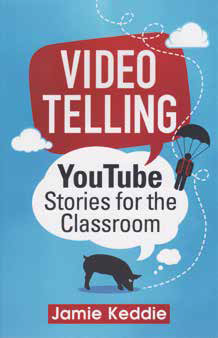Videotelling: YouTube Stories for the Classroom, Lessonstream 2017
Jamie Keddie
Lessonstream Books 2017

Great title, great cover, great opening story and a great introduction, and then what? Then it gets even better; videos and activities galore, with great descriptions throughout by the author on how to introduce and integrate them into the language classroom. Reading this book is like reading a punchy novel, full of endless cliffhangers that keep you turning the pages. This is the first book I have picked up where I can’t wait to try out every single activity and find out how the students will react.
I must admit I didn’t exactly know what Videotelling was before I opened up this book; but Jamie Keddie spells it out loud and clear in the introduction. The word, or rather phrase, Videotelling, was coined by him to explain the use of putting the questions, discussion and analysis first, before actually watching the video in question. This can open up a Pandora’s box of curiosity, psychological insights and a look at how much we have been pre-conditioned to think in certain ways and believe certain things. The book has been organised into five fat chapters that will fill you up to the brim with a rich resource of great video material and a variety of different approaches that teachers can follow, to stimulate their students’ interest and curiosity. Chapter 1 focuses on ‘Story’, as Keddie explains, ‘For me the ideal video is short in length and rich in narrative’. The next chapter, ‘Withholding Information’, plays with keeping things back in order to make the students think, imagine or guess what is coming next. Chapter 3 provides ‘a framework for dialogue’. Chapter 4 engages the students in interactive tasks – it is a versatile chapter, where the ideas can be applied to videos mentioned throughout the book. Chapter 5 leads the students into the realm of media literacy and the tricks of the trade. Here, they will also be expected to think about authenticity and the bias of the video-makers themselves.
In fact, Keddie’s five chapters are actually six. This is because his final Appendices are actually a final chapter. This section is choc-a-bloc full of advice and suggestions for teachers, ranging from how to deal with students who are impatient or simply disorderly, to how to work with those who just don’t want to participate. It includes a variety of storytelling techniques, from using non-verbal gestures and body position, to providing visual support from maps, sketches, actual objects and props. If you are new to teaching, here you will find vital tips; even if you are older and more jaded, you will discover some excellent insights.
The book begins and ends with Jamie Keddie’s favourite YouTube video ever, ‘about a mother and her baby. The baby is lying on the floor, sleeping, dreaming about whatever it is that babies dream about. The mother is taking advantage of the peace. She is sitting in the corner eating a snack’. If you don’t know this clip, you may be surprised about what happens next and who the mother and child really are. I was. (Buy the book to find out!)
I end this review with the only criticism I can think of, in the form of a question to Jamie Keddie: ‘Why, oh why didn’t you bring this book out sooner?’
Andy Starck
Tainan, Taiwan
Comments
Write a Comment
Comment Submitted